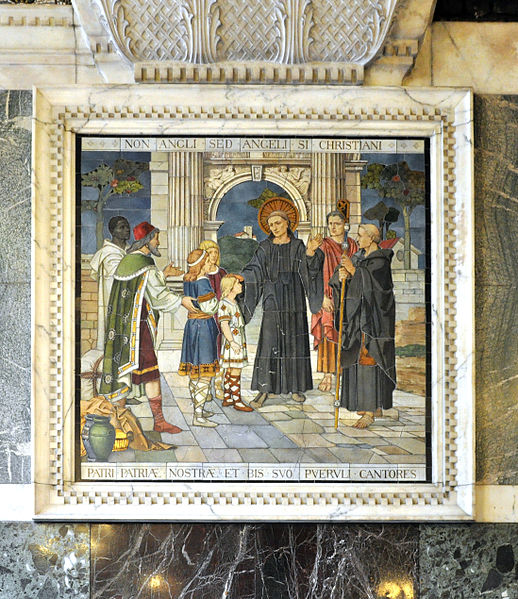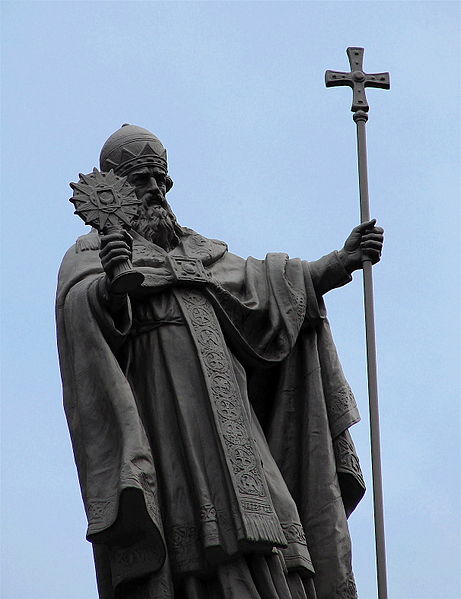Pope St. Gregory I (“the Great”)
Doctor of the Church; born at Rome about 540; died 12 March 604. Gregory is certainly one of the most notable figures in Ecclesiastical History. He has exercised in many respects a momentous influence on the doctrine, the organization, and the discipline of the Catholic Church. To him we must look for an explanation of the religious situation of the Middle Ages; indeed, if no account were taken of his work, the evolution of the form of medieval Christianity would be almost inexplicable. And further, in so far as the modern Catholic system is a legitimate development of medieval Catholicism, of this too Gregory may not unreasonably be termed the Father. Almost all the leading principles of the later Catholicism are found, at any rate in germ, in Gregory the Great. (F.H. Dudden, “Gregory the Great”, 1, p. v).
This eulogy by a learned non-Catholic writer will justify the length and elaboration of the following article.
I. FROM BIRTH TO 574
Gregory’s father was Gordianus, a wealthy patrician, probably of the famous gens Amicia, who owned large estates in Sicily and a mansion on the Caelian Hill in Rome, the ruins of which, apparently in a wonderful state of preservation, still await excavation beneath the Church of St. Andrew and St. Gregory. His mother Silvia appears also to have been of good family, but very little is known of her life. She is honoured as a saint, her feast being kept on 3 November. Portraits of Gordianus and Silvia were painted by Gregory’s order, in the atrium of St. Andrew’s monastery, and a pleasing description of these may be found in John the Deacon (Vita, IV, lxxxiii). Besides his mother, two of Gregory’s aunts have been canonised, Gordianus’s two sisters, Tarsilla and Æmilians, so that John the Deacon speaks of his education as being that of a saint among saints. Of his early years we know nothing beyond what the history of the period tells us.
Between the years 546 and 552 Rome was first captured by the Goths under Totila, and then abandoned by them; next it was garrisoned by Belisarius, and besieged in vain by the Goths, who took it again, however, after the recall of Belisarius, only to lose it once more to Narses. Gregory’s mind and memory were both exceptionally receptive, and it is to the effect produced on him by these disasters that we must attribute the tinge of sadness which pervades his writings and especially his clear expectation of a speedy end to the world. Of his education, we have no details. Gregory of Tours tells us that in grammar, rhetoric and dialectic he was so skilful as to be thought second to none in all Rome, and it seems certain also that he must have gone through a course of legal studies. Not least among the educating influences was the religious atmosphere of his home. He loved to meditate on the Scriptures and to listen attentively to the conversations of his elders, so that he was “devoted to God from his youth up”.

Non Angli, sed angeli – “They are not Angles, but angels”, spoken by Pope St. Gregory when he first encountered pale-skinned English boys at a slave market, sparking him to send St. Augustine of Canterbury to England to convert the English, according to Bede.
His rank and prospects pointed him out naturally for a public career, and he doubtless held some of the subordinate offices wherein a young patrician embarked on public life. That he acquitted himself well in these appears certain, since we find him about the year 573, when little more than thirty years old, filling the important office of prefect of the city of Rome. At that date the brilliant post was shorn of much of its old magnificence, and its responsibilities were reduced; still it remained the highest civil dignity in the city, and it was only after long prayer and inward struggle that Gregory decided to abandon everything and become a monk. This event took place most probably in 574. His decision once taken, he devoted himself to the work and austerities of his new life with all the natural energy of his character. His Sicilian estates were given up to found six monasteries there, and his home on the Caelian Hill was converted into another under the patronage of St. Andrew. Here he himself took the cowl, so that “he who had been wont to go about the city clad in the trabea and aglow with silk and jewels, now clad in a worthless garment served the altar of the Lord” (Greg. Tur., X, i).
II. AS MONK AND ABBOT (C. 574-590)
There has been much discussion as to whether Gregory and his fellow-monks at St. Andrew’s followed the Rule of St. Benedict. Baronius and others on his authority have denied this, while it has been asserted as strongly by Mabillon and the Bollandists, who, in the preface to the life of St. Augustine (26 May), retract the opinion expressed earlier in the preface to St. Gregory’s life (12 March). The controversy is important only in view of the question as to the form of monasticism introduced by St. Augustine into England, and it may be said that Baronius’s view is now practically abandoned. For about three years Gregory lived in retirement in the monastery of St. Andrew, a period to which he often refers as the happiest portion of his life. His great austerities during this time are recorded by the biographers, and probably caused the weak health from which he constantly suffered in later life. However, he was soon drawn out of his seclusion, when, in 578, the pope ordained him, much against his will, as one of the seven deacons (regionarii) of Rome. The period was one of acute crisis. The Lombards were advancing rapidly towards the city, and the only chance of safety seemed to be in obtaining help from the Emperor Tiberius at Byzantium.










